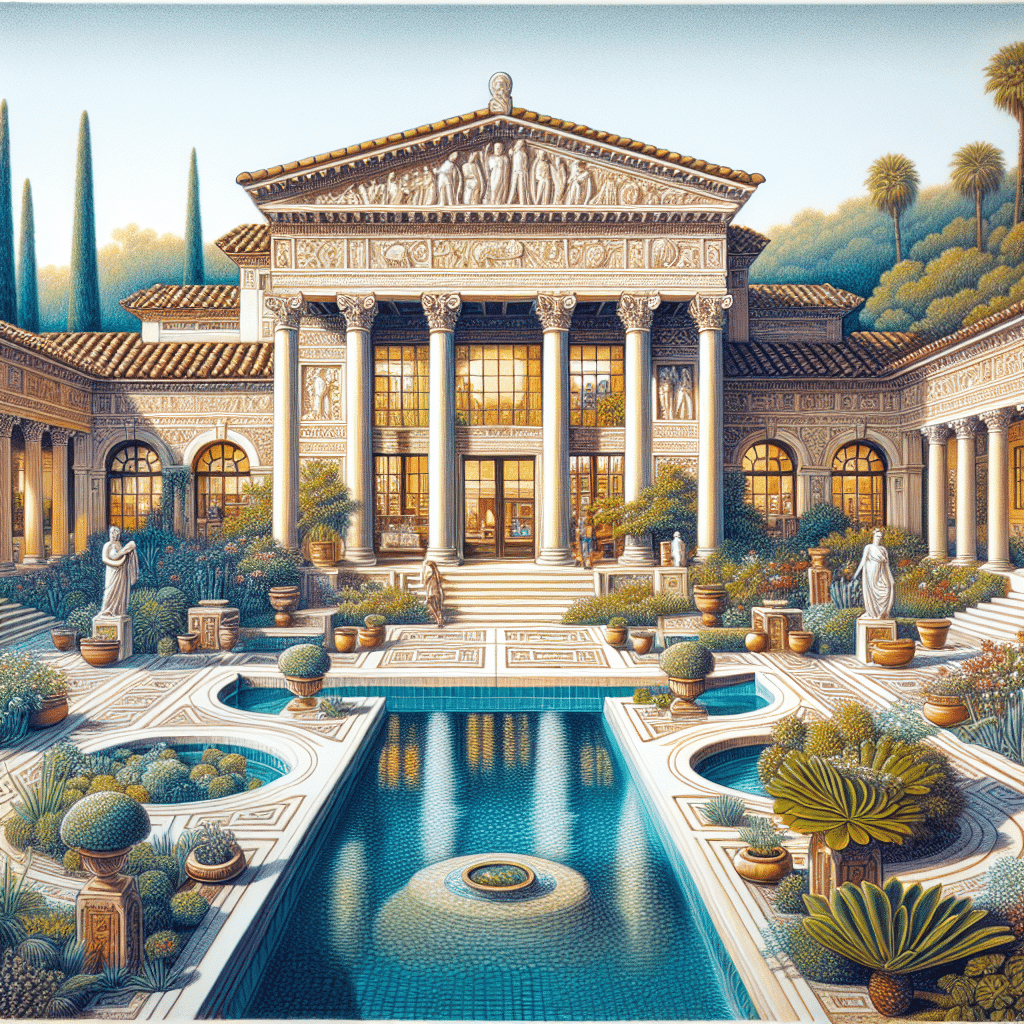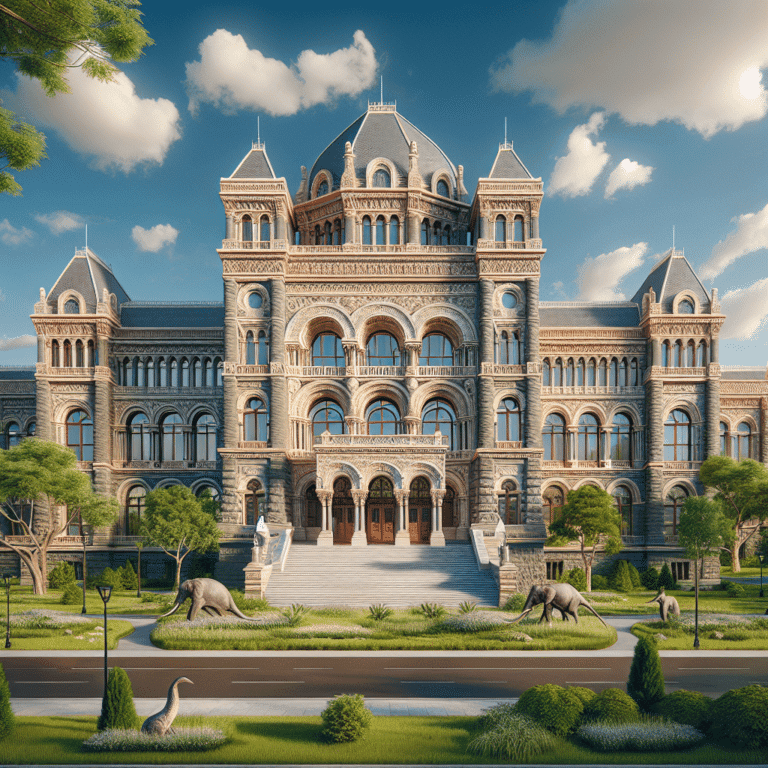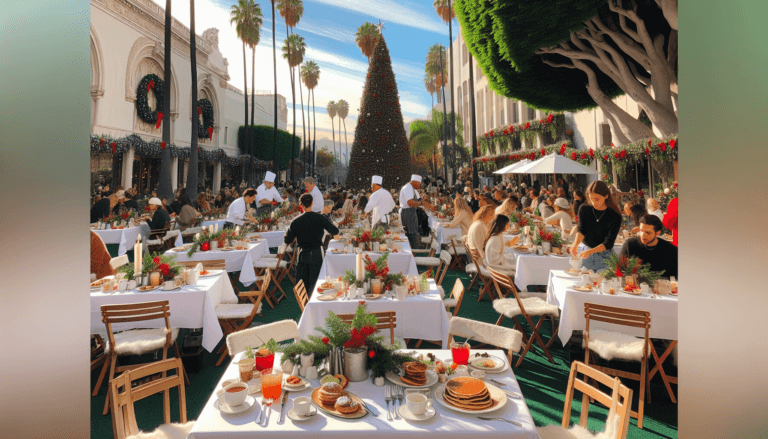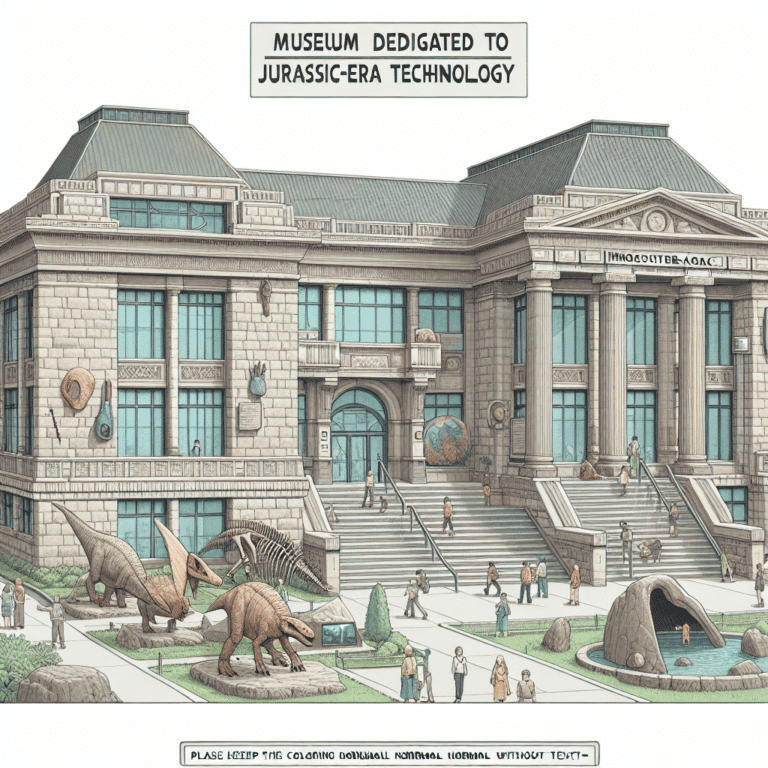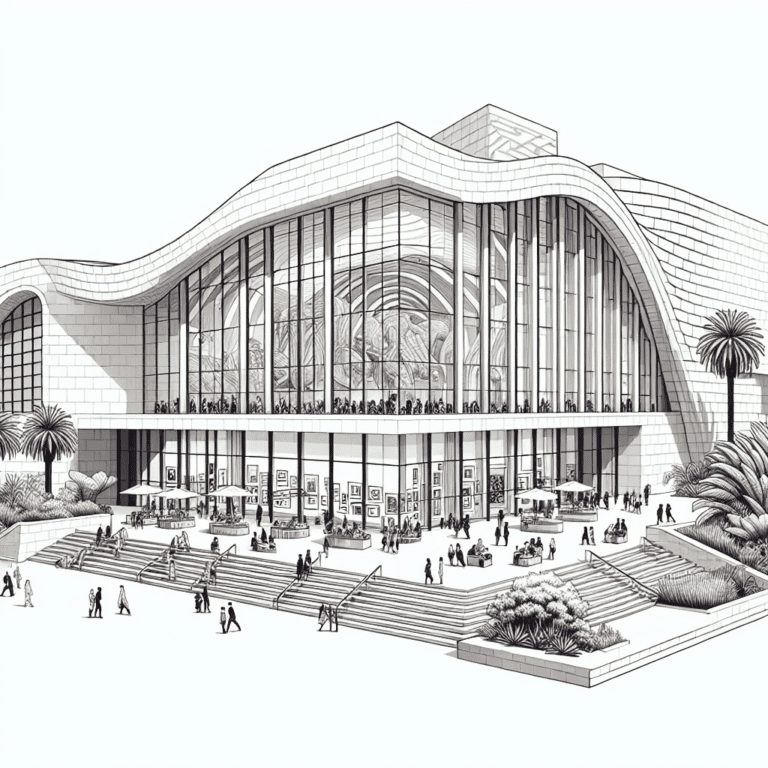The Getty Villa Chronicles: My Epic Journey through Time
Exploring Getty Villa
History and Architecture
I can’t help but feel excited every time I visit the Getty Villa, which first opened its doors in 1974 as a museum for ancient art. Nestled in Pacific Palisades, California, this stunning museum is designed to resemble a Roman country house. The architecture is inspired by the Villa dei Papiri in Herculaneum, which truly transports visitors back in time.
In 2006, the Getty Villa officially reopened, now serving as an educational center dedicated to the arts and cultures of ancient Greece, Rome, and Etruria. The intricate details and beautiful gardens of the villa capture the essence of ancient architecture and provide a breathtaking backdrop for the incredible artwork housed within.
Here’s a quick overview of the Getty Villa’s key historical milestones:
| Year | Event |
|---|---|
| 1974 | Getty Villa opens to the public |
| 2006 | Getty Villa reopens as an educational center and museum |
For anyone interested in ancient history, this place is a must-visit!
Collection Highlights
The Getty Villa is home to approximately 44,000 ancient works of art, making it one of the most comprehensive collections of ancient art in the United States. The collection features Greek, Roman, and Etruscan antiquities dating from 6,500 BC to A.D. 400. This impressive range allows visitors to explore the rich history of these ancient cultures in an engaging and informative way.
Among the highlights is the Lansdowne Heracles statue, acquired by the Getty Museum in 2010. This stunning piece is a testament to the artistry of ancient craftsmen and exemplifies the grandeur of the collection.
If you’re curious about other museums in the area, check out these amazing spots:
The Getty Villa truly offers an extraordinary experience for individuals or families looking to immerse themselves in history while enjoying the beauty of art and architecture.
Getty Villa’s Renovation
Renovation Details
My visit to the Getty Villa was made even more exciting knowing the extensive renovation it underwent. The renovation began in 1997, led by architects Rodolfo Machado and Jorge Silvetti. They aimed to restore the villa’s original aesthetic while incorporating modern amenities. This included creating a stunning re-creation of the Villa of the Papyri, which was buried by the eruption of Mt. Vesuvius in A.D. 79. The renovation was not just about aesthetics; it also involved restoring the villa’s antiquities before it reopened on January 28, 2006 (Getty History and Timeline).
The newly arranged galleries provide a chronological journey through ancient Greek, Roman, and Etruscan art. Visitors can explore 33 spaces across two floors, offering stunning views of the landscape and the Pacific Ocean. I found it fascinating how the architectural design was inspired by ancient Roman principles, creating an immersive experience right in Los Angeles (Getty Villa).
| Renovation Aspect | Details |
|---|---|
| Start Year | 1997 |
| Architects | Rodolfo Machado and Jorge Silvetti |
| Key Feature | Re-creation of the Villa of the Papyri |
| Reopening Date | January 28, 2006 |
| Number of Gallery Spaces | 33 |
Reopening and New Features
The reopening of the Getty Villa was like stepping back in time. The new galleries exhibit Greek, Roman, and Etruscan antiquities in a way that emphasizes their artistic significance rather than just thematic subjects. This approach invites visitors, including myself, to appreciate the art by understanding the historical, technological, and cultural contexts that influenced its creation (Getty Iris).
Some of the standout features I noticed included:
- Chronological Display: The art is arranged from the Neolithic and Bronze Age through the Archaic, Classical, and Hellenistic periods, culminating in an area dedicated to ancient Roman sculpture.
- Enhanced Visitor Experience: The galleries were designed to provide views of the villa’s beautiful gardens and the surrounding landscape, making the experience even more immersive.
The Getty Villa remains a must-visit location for anyone interested in art and history. For those looking for more cultural experiences in the area, check out other incredible places like the Los Angeles County Museum of Art (LACMA) and The Broad. Each location offers unique insights into art and culture that are not to be missed.
Getty Villa’s Collection
Ancient Artifacts
During my visit to the Getty Villa, I was blown away by its extensive collection of ancient artifacts. The villa houses approximately 44,000 works of art, primarily focusing on the ancient Greek, Roman, and Etruscan civilizations. These artifacts date from as early as 6,500 BC to 400 AD, making this one of the most comprehensive collections of ancient art in the United States.
| Artifact Name | Civilization | Year Created |
|---|---|---|
| Lansdowne Heracles | Greek | 4th Century BC |
| Statue of a Victorious Youth | Roman | 300 BC |
| Victorious Youth (Athlete) | Greek | 4th Century BC |
Notable pieces such as the Lansdowne Heracles and the Statue of a Victorious Youth (also known as the Getty Bronze), showcase the incredible craftsmanship of ancient artists. The Lansdowne Heracles, acquired by the Getty Museum in 2010, is particularly impressive, representing the hero Heracles in a powerful stance. I found it fascinating to learn how each piece tells a story of the culture and artistry of its time.
For anyone interested in exploring these remarkable artifacts, the Getty Villa is a treasure trove of history and artistic achievement.
Significant Art Pieces
In addition to the vast array of ancient artifacts, the Getty Villa features significant art pieces that truly captivated my attention. The collection includes iconic works such as the Getty Bronze, which stands as a testament to ancient Greek athleticism and artistry.
| Art Piece | Description |
|---|---|
| Lansdowne Heracles | Statue depicting Heracles, symbolizing strength |
| Getty Bronze | Statue of a victorious youth, showcasing realism |
| Victorious Youth (Athlete) | Representation of an athlete, highlighting physical beauty |
Each art piece in the collection offers a unique glimpse into the past, and I found myself marveling at the details and historical significance of each one. The artistry, the stories, and the craftsmanship behind these works are truly awe-inspiring.
Exploring the collection at the Getty Villa was not just about seeing art; it was about connecting with history and experiencing the beauty of ancient civilizations. For those looking for a fun and educational outing in Los Angeles, the Getty Villa is a must-visit destination that offers a deep dive into the world of ancient art. If you’re interested in other museums, check out our list of the best los angeles museums for more options!
Getty Villa’s Educational Programs
As I wandered through the stunning halls of the Getty Villa, I was thrilled to discover the multitude of educational programs available. The villa not only showcases incredible art but also supports a vibrant learning environment that invites individuals and families to immerse themselves in history and culture.
Scholarly Endeavors
The Getty Villa places a strong emphasis on scholarly pursuits. It offers collaborative research opportunities that support the fields of art, conservation, and archaeology. For those interested in deepening their understanding of ancient cultures, the villa hosts a variety of public programs, lectures, and conferences covering diverse themes related to ancient art and cultures. This creates a dynamic space where I could engage with experts and fellow enthusiasts alike.
| Program Type | Description |
|---|---|
| Research Opportunities | Collaborative projects focusing on art, conservation, and archaeology. |
| Public Lectures | Talks by experts on various themes related to ancient cultures. |
| Conferences | Gatherings that explore specific topics in depth. |
For more information on these initiatives, visit the Getty Villa’s educational programs.
Public Programs and Events
The villa also offers an impressive range of activities designed for visitors of all ages. From theater performances to workshops and family events, each program is inspired by the ancient world. These events provide a hands-on experience that makes learning about history fun and interactive.
One of the most exciting initiatives is the “Classical World in Context,” which explores cross-cultural influences between Greece, Rome, and other Mediterranean cultures. This multi-year project examines artistic and cultural exchanges, shedding light on how classical influences shape contemporary art (Getty Iris).
| Event Type | Description |
|---|---|
| Theater Performances | Live shows inspired by ancient stories and themes. |
| Workshops | Interactive sessions where visitors can create art or learn skills. |
| Family Events | Activities designed for families to explore together. |
I found that these engaging programs not only enhance the overall experience at the Getty Villa but also foster a deeper appreciation for art and history. Whether you’re visiting with friends, family, or on your own, the educational programs at the Getty Villa provide a fantastic opportunity to explore and learn. For a broader look at museums in the area, check out our guide on best los angeles museums.
Getty Villa’s Gardens
Roman-style Gardens
Visiting the Getty Villa is like stepping back in time, and the gardens play a significant role in that experience. The villa features several stunning Roman-style gardens, including the Outer Peristyle, Inner Peristyle, and East Garden. Each garden is meticulously designed to reflect the beauty of ancient Roman landscaping.
The Outer Peristyle is particularly enchanting, surrounded by 28 Roman columns that frame a tranquil reflecting pool. This architectural feature mimics classical Roman villas and creates a serene atmosphere that invites visitors to relax and enjoy the scenery. The Inner Peristyle design draws inspiration from the ruins of Pompeii and Herculaneum, showcasing planting beds, fountains, and a reflecting pool encircled by vibrant geometric patterns reminiscent of ancient times (Getty Villa).
| Garden Name | Key Features |
|---|---|
| Outer Peristyle | 28 Roman columns, reflecting pool |
| Inner Peristyle | Planting beds, fountains, geometric patterns |
| East Garden | Ancient Roman plants and design elements |
Features and Design
The design of the gardens at the Getty Villa is not just beautiful but also historically informative. Each garden showcases plants and features typical of ancient Roman homes, allowing visitors to gain insight into the past. The incorporation of original Roman art and replicas throughout the villa enhances the overall experience, immersing guests in a world filled with ancient culture (Getty Villa).
The gardens are thoughtfully designed to include elements such as fountains and intricate pathways that guide visitors through the lush greenery. The combination of classical architecture and vibrant flora creates a picturesque setting perfect for family visits or quiet reflection.
Exploring the gardens is just one of the many highlights of visiting the Getty Villa. It’s a delightful journey that combines art, history, and the beauty of nature, making it a must-see destination in Los Angeles. For more cultural experiences in the area, check out our list of best Los Angeles museums.
Getty Villa’s Admission
Ticket Information
I was thrilled to discover that admission to the Getty Villa is free! However, I found out that an advance, timed-entry ticket is required for entry (Getty Villa). This system helps manage visitor flow and enhances the experience for everyone. Below is a simple table outlining the ticketing details:
| Ticket Type | Cost | Advance Booking Required |
|---|---|---|
| General Admission | Free | Yes |
| Special Events | Varies | Yes |
Make sure to book your tickets in advance to secure your preferred time slot!
Visitor Information
Visiting the Getty Villa is an exciting experience for individuals and families alike. The Villa’s architecture, inspired by the ancient Roman country house, creates a captivating atmosphere that transports visitors back in time.
Here are some key details to keep in mind while planning your visit:
| Information | Details |
|---|---|
| Location | Malibu, California |
| Opening Hours | 10:00 AM – 5:00 PM, Tuesday – Sunday |
| Closed | Mondays and certain holidays |
| Accessibility | Wheelchair accessible |
When visiting, don’t forget to explore the educational programs offered at the Getty Villa, which support various scholarly endeavors in art and archaeology. These programs include public lectures, conferences, and hands-on activities for everyone to enjoy (Getty Villa).
For more exciting places to visit, check out our list of best los angeles museums and make the most of your time in this vibrant city!
Getty Villa’s Influence
Architectural Inspiration
Visiting the Getty Villa is like stepping back in time, thanks to its stunning architectural design. The villa is modeled after the ancient Roman country house, the Villa dei Papiri in Herculaneum, which was buried by the eruption of Mount Vesuvius in A.D. 79. The layout and garden designs reflect the grandeur of Roman architecture, complete with an outer peristyle that features 28 magnificent columns surrounding a serene open courtyard. This courtyard overlooks a beautiful reflecting pool, inspired by ancient models, which adds to the villa’s tranquil atmosphere.
The design of the Inner Peristyle garden is equally impressive. It draws inspiration from the ruins of Pompeii and Herculaneum, featuring planting beds, fountains, and a reflecting pool surrounded by colorful geometric patterns reminiscent of ancient Roman style. Exploring these architectural elements allows me to feel connected to a rich history while enjoying the beauty of the present.
Cultural Exchange Initiative
The Getty Villa is not just a display of ancient art and architecture; it also serves as a hub for cultural exchange. Through various programs and exhibitions, the villa promotes understanding and appreciation of ancient Roman culture. Visitors can experience this firsthand through educational initiatives that highlight the significance of the artifacts on display and their relevance to modern society.
By incorporating original Roman art and replicas into its design, the Getty Villa immerses guests in the world of ancient Rome. This cultural exchange initiative fosters a deeper understanding of historical contexts and encourages dialogue about the influence of ancient cultures on contemporary life (Getty Villa). For anyone looking to explore more about arts and history, the Getty Villa is undoubtedly a must-visit destination in Los Angeles, alongside other remarkable museums like the Getty Center and LACMA.
Getty Villa’s Reinstallation
Artistic Journey
Visiting the Getty Villa after its recent reinstallation feels like embarking on an artistic journey through time. The newly arranged galleries offer a chronological exploration of ancient Greek, Roman, and Etruscan art, showcasing pieces from the Neolithic and Bronze Age all the way to the dramatic skylit halls of ancient Roman sculpture. The visitor’s path takes me through 33 spaces on two floors, allowing for a comprehensive experience that connects the past with the present (Getty Iris).
This new display returns to the founding vision of J. Paul Getty, emphasizing the antiquities as works of art rather than just thematic subjects. Understanding the historical, technological, and cultural contexts that shaped these masterpieces enhances my appreciation of the art. Each piece tells a story, and the arrangement invites me to explore these narratives in a more profound way.
| Feature | Description |
|---|---|
| Number of Spaces | 33 |
| Floors | 2 |
| Art Periods Covered | Neolithic to Hellenistic |
| Highlighted Collections | Cycladic figurines, Roman sculpture, Hellenistic bronzes |
Enhanced Experience
The reinstallation of the Getty Villa not only focuses on the art itself but also improves the overall visitor experience. Enhanced lighting and technology, including new audio tours and digital labels, create a more immersive environment. I found the digital labels particularly helpful, as they provide additional context and insights about the artifacts on display.
The thoughtful arrangement and presentation of the collection allow me to appreciate the strengths of the antiquities, such as the intricate jewelry and goldwork. The journey through these galleries is not only visually stunning but educational. I leave feeling enriched by the knowledge I’ve gained and excited to share my experience with friends and family.
For anyone seeking an engaging cultural experience in Los Angeles, the Getty Villa stands out as a must-visit destination. It’s a place where history, art, and technology come together to create an unforgettable adventure. If you’re interested in exploring more museums, check out our list of the best los angeles museums.

